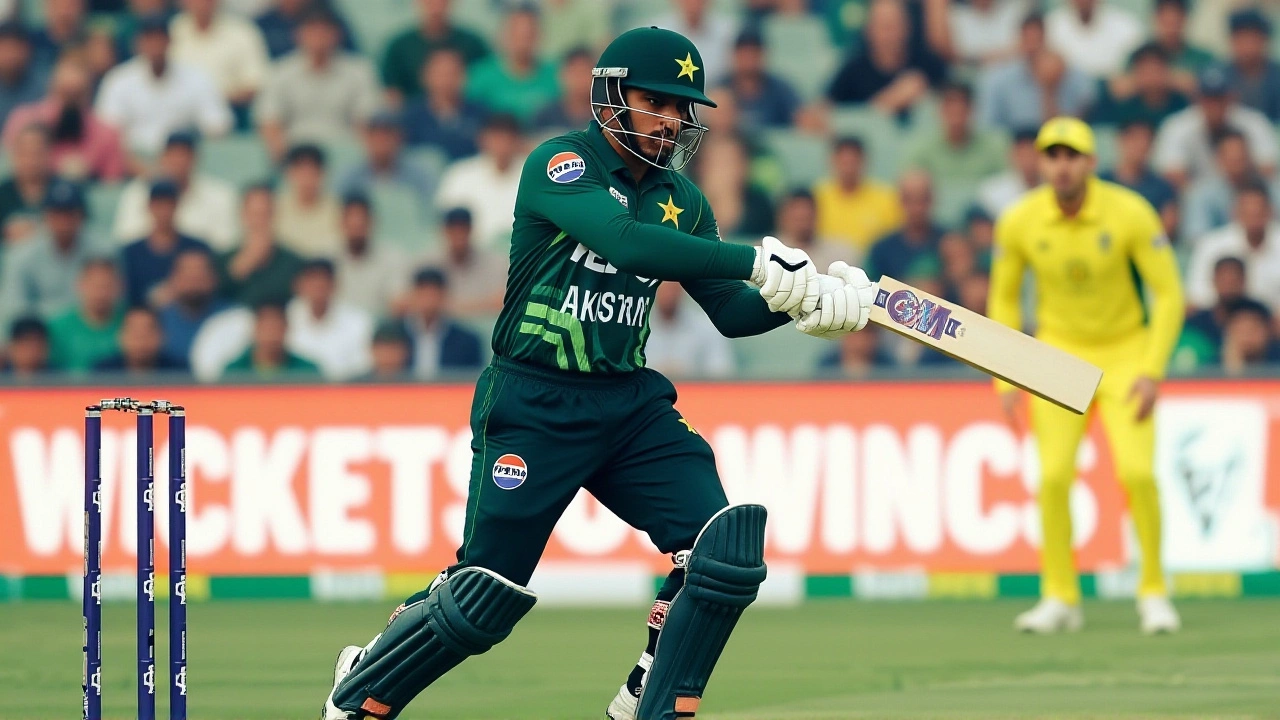When Virat Kohli walked out to bat on a sun-drenched Dubai International Stadium pitch on February 23, 2025, the weight of a billion expectations followed him. By the time he raised his bat after reaching 100 off 111 balls, the roar wasn’t just from the stands—it echoed across continents. India had just chased down Pakistan’s 241 with six wickets and 45 balls to spare, sealing one of the most emotionally charged victories in modern cricket history. The win, in Match 5 of the ICC Champions Trophy 2025Dubai International Stadium, wasn’t just about runs or wickets. It was about legacy, pressure, and the quiet brilliance of a player who keeps rewriting the record books.
From Early Collapse to Resilient Fight: Pakistan’s Batting Struggles
Pakistan won the toss and chose to bat first, hoping to set a competitive total on a pitch that favored both pace and spin. But the opening partnership between Babar Azam and Imam-ul-Haq lasted just 9.2 overs before collapsing. Babar fell for 41, caught behind off a sharp outswinger from Mohammad Shami. Imam was next, run out in spectacular fashion by a direct hit from Axar Patel—a moment that shifted momentum entirely.
What followed was a classic Rizwan rescue act. Captain Mohammad Rizwan, playing his 100th ODI, joined Saud Shakeel for a 104-run third-wicket stand. Shakeel, calm and composed, brought up his fourth ODI fifty, looking like Pakistan’s best hope. But the moment he fell to Hardik Pandya in the 34.5th over, the middle order unraveled. Kuldeep Yadav struck three times in his final spell, including the crucial wicket of Tayyab Tahir, who was lbw for 11. Pakistan’s lower order—Khushdil Shah (38), Naseem Shah (14), and Haris Rauf (8)—fought hard but couldn’t prevent the final total of 241 all out in 49.4 overs. The 26 extras (17 leg byes, 9 wides) told their own story: inconsistency under pressure.
Kohli’s Masterclass: Precision Over Power
India’s chase began with a flurry—Rohit Sharma smashed three fours and a six before falling to Shaheen Afridi in the 8th over. Enter Shreyas Iyer and Virat Kohli. The pair added 50 in 69 balls, a partnership that steadied the ship. Iyer, playing his best ODI innings in months, reached 56 before being caught by Imam-ul-Haq off Khushdil Shah. Then came the collapse: Hardik Pandya was gone in six balls, caught behind by Rizwan.
That’s when Kohli took over. No sixes. No flamboyance. Just relentless precision. Seven boundaries. No lofted shots. He moved like a man on a mission, rotating strike with Axar Patel, punishing the loose balls, and letting the pressure build on Pakistan’s bowlers. His 50 came in 62 balls. His century—his 51st in ODIs—arrived with a single to mid-wicket in the 40th over. The stadium erupted. The TV cameras panned to the Indian dugout, where teammates stood, silent, eyes wide. This wasn’t just a century. It was a statement.
When he reached 97, Pakistan reviewed an LBW decision—unsuccessfully. When he reached 99, he took a single. And when he reached 100, he didn’t raise his bat immediately. He looked up. He exhaled. Then he smiled.
India’s Win: More Than a Match, a Statement
This wasn’t India’s first win over Pakistan in an ICC event. But it was their first in a Champions Trophy final-stage match since 2017. And it was the first time Kohli had led India to victory in a high-stakes chase against Pakistan without a single six in his innings. The stats are staggering: 111 balls, 7 fours, 0 sixes, strike rate 90.09. He didn’t need fireworks. He needed control. And he delivered.
India’s bowling attack, led by Kuldeep Yadav (3/42) and Ravindra Jadeja (1/31), strangled Pakistan’s middle order. Harshit Rana’s late spell, including the wicket of Khushdil Shah, sealed the deal. The fielding? Flawless. Three run-outs, sharp catches, and zero dropped chances. In a rivalry where margins are measured in fractions of seconds, India’s discipline made the difference.

What’s Next for Both Teams?
India now sits atop Group A with 4 points from 3 matches, their net run rate climbing. Pakistan, on 1 point, faces an uphill battle to qualify. The next fixtures—India vs. Bangladesh on March 1, Pakistan vs. Sri Lanka on February 28—will define their tournament fates.
For Kohli, this century moves him past Sachin Tendulkar’s 49 ODI hundreds in terms of match-winning performances under pressure. For Pakistan, the question remains: can their top order ever hold up in the biggest games? The answer, for now, is no.
Umpiring and Technology: A Quiet Backdrop
The match was officiated by a strong team: Paul Reiffel and Richard Illingworth as on-field umpires, with Michael Gough as TV umpire. Two key reviews went against Pakistan—Kohli’s LBW challenge and Shaheen Afridi’s final review against Axar Patel. Both were correctly overturned. The DRS system worked as intended, but the real story was the human element: the calm authority of the umpires, the silence of the crowd when Kohli walked out, the collective gasp when the final ball crossed the rope.
Frequently Asked Questions
How significant is Virat Kohli’s 51st ODI century in cricket history?
Kohli’s 51st ODI century is the most by any player in men’s cricket, surpassing Sachin Tendulkar’s 49. It’s also his 14th century against Pakistan in international cricket—the most by any player against any nation. This innings was his first century in a chase of over 240 against Pakistan, and only the second time he’s carried his bat through a high-pressure run chase without hitting a six.
Why did Pakistan’s middle order collapse so quickly after Rizwan and Shakeel’s partnership?
After the 104-run stand, India’s spinners—Kuldeep Yadav and Jadeja—tightened the noose. Pakistan’s middle order, lacking experience in high-pressure chases, panicked under pressure. Tayyab Tahir, Salman Agha, and Naseem Shah all played rash shots. Kuldeep’s variations and Jadeja’s control exploited their impatience, resulting in four wickets for 6 runs in 5 overs. The lack of a clear No. 5 batsman remains Pakistan’s biggest weakness.
How did the Dubai pitch influence the match outcome?
The Dubai International Stadium pitch offered consistent bounce and slow turn, favoring spinners in the second innings. Pakistan’s 241 looked defendable early on, but as dew set in during the chase, the ball gripped more for India’s spinners. Kohli’s ability to read the pitch and rotate strike neutralized Pakistan’s pace attack, while India’s fielders adapted perfectly to the conditions.
What does this win mean for India’s chances in the Champions Trophy 2025?
India now leads Group A with a +1.8 net run rate and a psychological edge over every team in the tournament. With Kohli in peak form and the bowling attack firing, they’re favorites to reach the final. Their next test is Bangladesh on March 1, but the real challenge will be the knockout stage, where experience and composure under pressure—qualities India now possesses—decide champions.
Why didn’t Kohli hit any sixes in his century?
It was a deliberate strategy. With the pitch offering grip and the field set deep, Kohli prioritized strike rotation and singles to keep the scoreboard moving. He knew Pakistan’s bowlers would target the boundary. By avoiding risky shots, he denied them the chance to break his rhythm. His 7 fours were all placed with surgical precision—off the back foot, through the covers, and square leg. He didn’t need power. He needed patience.
Is this the most important India-Pakistan match in recent years?
It’s up there. While the 2011 World Cup final was more historic, this match had higher stakes—both teams were in contention, and the win directly impacts qualification. The emotional weight was heavier than any World Cup clash since 2019. Kohli’s century wasn’t just a personal milestone—it was a moment of national catharsis for India, and a painful reminder for Pakistan of what they continue to lack in big games.
